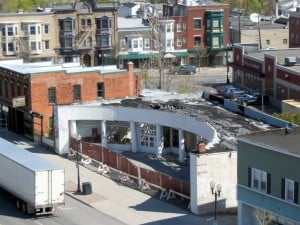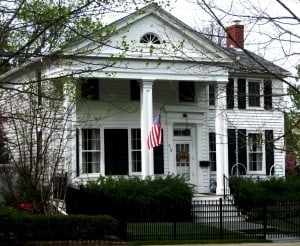No Free Money: Historic Preservation 101
By John Marks, Curator of Collections and Exhibits
When people consider buying an old house in Geneva, they often call the historical society. A standard question is, “Is there free money to restore my old house?”
Short answer: No, there isn’t
The long answer has several parts. Old houses are not necessarily historic, and there are several levels of recognition. Government historic preservation grants generally aren’t available to individual homeowners. So why restore an old house? (Restoration refers to identifying and preserving original materials and carefully replacing missing elements, as opposed to wholesale modernization of an exterior, i.e. vinyl replacement windows.)
What’s a historic house?Fifty years is a common measurement for “historic” or “antique”. By age alone, ranch houses built in the early 1960s can be considered historic. Time is only one consideration. The New York State Historic Preservation Office (NYSHPO) has a list of criteria for declaring a house, commercial building, or place historic. (Every state has an Historic Preservation Office or “shippo”.)
“The quality of significance in American history, architecture, archeology, engineering, and culture is present in districts, sites, buildings, structures, and objects that possess integrity of location, design, setting, materials, workmanship, feeling, and association, and:
- that are associated with events that have made a significant contribution to the broad patterns of our history; or
- that are associated with the lives of persons significant in our past; or
- that embody the distinctive characteristics of a type, period, or method of construction, or that represent the work of a master, or that possess high artistic values, or that represent a significant distinguishable entity whose components may lack individual distinction; or
- that have yielded, or may be likely to yield, information important in prehistory or history.
In plain English, a house needs to be associated with an historical event or person, have significant architectural merit, or be part of a district (neighborhood or street) that meets these criteria. South Main Streetfrom William Street to “the cemetery dip” is a federally-recognized historic district.
Who decides what’s historic?
Three levels of government may designate historic structures: local, state, and federal. The City of Geneva has an Historic Districts and Structures Commission that recognizes significant buildings. Created in 1969, there are two historic districts (South Main Street and Genesee Park) and 20 individual buildings.

Genesee Park, which includes this house, is a city historic district which was added to the National Register of Historic Places in 2002.
New York State and the federal government both have Registers of Historic Places with identical criteria (see above); if the SHPO recognizes a property, they recommend that the National Park Service do the same. There are two National Register districts, identical to the city’s districts, and 11 buildings and places.
Local designations offer the most protection to historic buildings. Geneva’s commission reviews any changes to the exteriors of historic buildings that are visible from the street, and must approve the demolition of protected properties. Federal protection of historic properties only applies if government money is involved, i.e. buildings on the National Register are being demolished for a federal highway. Section 106 of the National Historic Preservation Act of 1966 states that an Advisory Council must be allowed to comment on the impact of demolition; this rarely results in the cancellation of projects.

Before the gas station on Main Street was demolished, Section 106 was invoked because federal money was involved and the building was eligible for the National Register.
Is there any financial help to restore an old house?
There is a New York State Historic Homeownership Rehabilitation Tax Credit, but it’s not available to everyone. In addition to being listed on the State or National Register of Historic Places, “the house needs to be located in an eligible census tract.” (Whatever that means.) That’s just the beginning of the red tape.
The Historical Society administers the Fund for Historic Geneva, a 3%-interest loan program for preservation of historic homes in the city of Geneva. Properties need to be on the list of city-recognized historic structures, or be eligible for inclusion, as determined by the Fund committee. (If you’re not sure, just ask.) Preservation projects include: restoration or installation of period windows, detailed soffits and facias, period shutters, period gutters (such as Yankee style), etc. Sadly, the program does not cover routine maintenance such as painting and routine roofing.
If there are no outright grants (aka “free money”), why should I do it?
Because you want to. Restoring an old house is not for the faint of heart. Neither is competing in triathlons, another activity which consumes many hours of free time and thousands of dollars – yet many people pursue it. A well-preserved old home may fetch a higher price when it comes time to sell (or it may not), but ultimately you need to do restoration because you want to.
The above is a very simplified description of historic preservation. For more information:
- National Register of Historic Places
- New York State Historic Preservation Office
- Landmark Society of Western New York – Based in Rochester, the Landmark Society of Western New York has excellent articles and links for preservation information.
- Historic Zoning in Geneva – The Historic Zoning portion of Geneva’s municipal code lists city-designated historic properties and districts, and details the duties of the Historic Districts and Structures Commission


